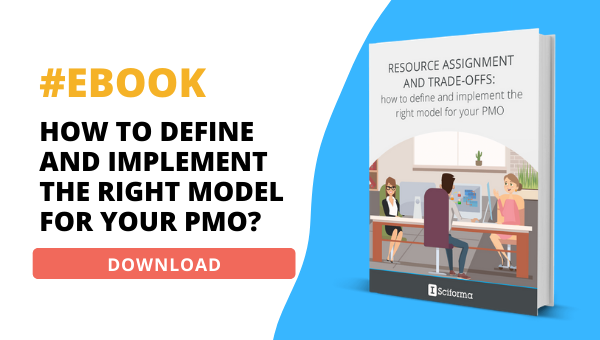The term “project portfolio management” is becoming increasingly prevalent in business spheres and has even grown ubiquitous in project-oriented firms. Hence the importance of having a proper understanding of PPM concepts and practices. What is portfolio management, and particularly, what is portfolio management in the context of project management? What exactly is a portfolio of projects? And what value and benefits can an organization or a PMO derive from aggregating projects into portfolios? How should project leaders manage a portfolio of projects, and why? These are some of the topics we’ll cover in this article.
What is a Project Portfolio?
A portfolio of projects is simply a set of projects managed together to achieve strategic goals or benefits. Unlike individual projects, which have specific deliverables, a portfolio supports the strategic directions of the enterprise or business function. Grouping multiple, interrelated initiatives into portfolios makes it possible to optimize the allocation, the prioritization, and the scheduling of resources across multiple projects against the financial and strategic goals of the organization.
Just like an investment portfolio — a grouping of financial assets such as stocks, bonds, currencies, and commodities owned by an investor, who needs to make sure the mix of assets offers good balance to maximize profit with limited or controlled risk — a project portfolio needs balance between short- and long-term projects, as well as high-risk/high-value initiatives and bread-and-butter projects.
What is Project Portfolio Management?
To quote Project Portfolio Management expert Harvey A. Levine, one of the most widely respected authorities in the domain, “PPM is the management of the project portfolio so as to maximize the contribution of projects to the overall welfare and success of the enterprise.”
While, for the Project Management Institute, Project Portfolio Management is the “centralized management of one or more portfolios that enable executive management to meet organizational goals and objectives through efficient decision making on portfolios, projects, programs, and operations.”
As the discipline focuses on managing collections of interconnected and interdependent projects, it requires coordinating multiple initiatives which share productive, financial, and human resources. Portfolio Managers need to make sure they understand the various projects under their purview with focus on connections and dependencies.
The Project Portfolio Management process helps PMOs determine the best way to sequence, arrange, and prioritize a mix of projects in order to generate synergies and improve execution efficiency, to diversify risk, and to better align project-related activities with the strategic and tactical goals of the organization.
What is the Draw of Project Portfolio Management?
A business usually starts feeling the need for a formal Project Portfolio Management approach when sizable growth in the number and complexity of project opportunities compels Project Managers and PMOs to make tough trade-off decisions. A firm’s budget, cashflow, equipment, and resource capacity are essentially limited. Allocating the available productive means across a handful of simple and straightforward projects is generally a no-brainer. However, scheduling and prioritizing dozens of interrelated initiatives across multiple domains requires a bit more preparation and capability.
Inflated pipelines
There are usually many different sources of projects for an organization. Product managers and product owners, executive leaders, heads of operations, marketing and sales teams are just a few of the functions and stakeholders which may ideate projects and push for their execution. Without a sound and established process for filtering, sequencing, and organizing project ideas and demands, organizations end up with an inflated pipeline of projects that proves too heavy to manage, and/or with a chaotic bunch of mismatched, contradictory or redundant projects. In any case, this lack of clarity and control over projects results in mediocre project performance — which directly correlates with organizational inability to realize the strategies and fulfill the mission of the business.
Optimizing project selection
Portfolio Management capabilities help PMOs stabilize and optimize the management of their projects and achieve more predictable and aligned outputs. The purpose is to maximize the benefits that the organization derives from its investments in projects.
First of all, a portfolio approach to Project Management helps Project Management Offices to select and prioritize the best projects. What are the best projects from a Portfolio Management perspective? Simply put, the highest-value projects are those that maximize the benefits for the firm, not only from a purely financial ROI standpoint, but also considering the strategic objectives and the long-term roadmap of the organization.
Analyzing risk
Yet another consideration is the balance of the portfolio itself. The make up of a portfolio of projects should be defined so as to optimize the overall risk profile and exposure. Which means that the incorporation of any project into a portfolio requires performing an impact assessment to evaluate the consequences on the project mix.
Connecting with strategy
Project Portfolio Management contributes to strengthening the bond between the enterprise’s strategic vision, tactical plans, and project activity. Improved understanding of the strategic impact of projects can also be leveraged to review and possibly adjust an active portfolio so as to adapt it to changes in the business environment or priorities. For example it might make sense to decide to pause or terminate in-flight projects, or to revise the distribution of strategic resources across competing projects.
Allocating resources
Which brings us to another key use case of Portfolio Management: optimizing the allocation and use of the organization’s pool of productive resources in order to maximize the value that the business gets from its projects. It is, here again, all about getting the best value for your money. As your resources are limited, you need to see to it that they are utilized to complete those projects that will bring you the best results.
From a Project Management point of view, proper resource allocation already requires solving complex equations: you need to plan your resources taking into account their respective skills and areas of expertise, their personal constraints (e.g. time off), and the requirements of the project schedules. Portfolio Management introduces further complexity by adding the consideration of the respective value of the different projects. In PPM, truly maximizing the payback from resource investments also requires differentiating between resources: while some can be considered as dispensable or replaceable (and can therefore be managed with more flexibility), rare, costly, or highly strategic resources should really be allocated and assigned according to a thoroughly thought-out plan.
Benefits of Project Portfolio Management
Although the benefits derived from the implementation and adoption of the PPM process may vary from one organization to the next, here are some of the organizational gains that firms across industries have reported thanks to Project Portfolio Management.
“Big Picture” view
It is too easy to get caught up in the emergencies that come with “business as usual” and lose focus on longer-term business objectives and roadmap. The Project Portfolio Management discipline helps teams put things in perspective and keep a clear line of sight to the organization’s long-term goals and strategies. Additionally, PPM assists in setting clear and objective goals, with well-defined milestones and targets to help measure progress over time. This ultimately results in more informed decision-making based on more accurate and objective data.
Improved performance metrics
Because Portfolio Management ties the realization of the firm’s strategy to the proper execution of the right projects, it places emphasis on project performance monitoring and controlling. With PPM, Portfolio Managers and PMOs continuously assess the health of projects and portfolios in real time against defined baselines and thresholds. The goal is to make sure that project activity stays on track to delivering the desired outcomes. This means more accurate and reliable performance data — which, in turn, translates into better understanding of project life cycles and improved ability to respond to shifts in a timely manner so as to increase the on-time delivery rate.
Enhanced collaboration across teams
As multiple project teams or groups across different business units and functions often share the use of a common pool of resources, they are de facto competing for resource access. This is particularly true in larger firms with a pyramidal organizational model. Project Portfolio Management uses a value-based approach to objectivize the selection and prioritization of initiatives and the distribution of strategic resources. As a result, disputes and conflicts over shared means of production give way to a more collaborative mindset. Besides, the “business first”, fact-based approach of the Project Portfolio Management process encourages a more open culture, free from managerial bias.
Decreased risk
Whereas the Project Management discipline focuses on the risks associated with the execution of individual projects, Project Portfolio Management considers the risk/return profile of the whole portfolio of projects and allows for any contingency by defining risk mitigation and remediation plans.
How to Build and Manage a Portfolio of Projects
If the PPM benefits and advantages outlined here above have convinced you to take the leap and implement Project Portfolio Management methods, here are a few guidelines and pieces of advice to help you build and manage great portfolios of projects.
Building a project portfolio
First of all, you’ll want to build a solid portfolio comprised of projects that are both profitable and beneficial and that will serve the long-term interests of your business. To this end, you need to devise and implement standard practices and processes to filter the project requests and measure them against a handful of key criteria, such as the alignment with corporate strategies, effective utilization of organizational resources, and return versus risk.
The proposal evaluation and selection process that you come up with should match your organization’s unique challenges and culture, and it is crucial for you to communicate and explain it clearly to everyone concerned. To prevent any misunderstandings or misalignments, don’t hesitate to go back to the basics by providing organization-specific definitions of such concepts as “value”, “benefits”, “risk”, “strategy”… These aren’t always that obvious!
Managing a project portfolio
You will need an equally sound process to manage your portfolio of projects and optimize it over time. PPM should be understood as a dynamic, continuous decision-making process aimed at constantly enhancing value and return while managing uncertainty and risk.
Optimizing resources
While Project Management strives to have individual projects meet their schedule, cost, and scope targets, the purpose of Project Portfolio Management is to preserve the benefits and return that you’re hoping to achieve by completing those projects. This involves making periodic decisions about the reallocation of resources and budgets across projects, or about the reprioritization of initiatives based on new developments or information. When making such adjustments, it is of key importance to update your risk and return evaluations to make sure you maintain a healthy mix of projects.
Expecting change
Another important consideration: you need to be aware that there is no guarantee whatsoever that the first PPM process you define and implement will be the best one for your organization, or even the right one. The Project Portfolio Management process is at the crossroads of so many organizational issues and business domains that getting it absolutely right the first time around is actually quite unlikely. Be prepared to test-and-learn, to challenge your initial expectations and decisions, and to adapt in real time. The ability to depend upon well-established PMO teams and on a solid network of sponsors and partners across the firm can significantly help you to get the constructive feedback you’ll need in order to accelerate that optimization process.
Implementing PPM tools
A last tip: it is essential to make sure that your project organization enjoys the support of professional PPM tools. Industry-grade software tools dedicated to the management of project portfolios will centralize and consolidate your data to provide you with the accurate, reliable, and fresh information that you need to make the right calls and manage your portfolio successfully. PPM platforms also simplify and automate tasks for project team members, freeing them up to engage in higher value-added work. Last but not least, such tools provide a framework that’ll support your process standardization effort and help bring structure to the management of activities across the organization.
Connecting to strategy
The Project Portfolio Management process is implemented to bridge the gaps and break down the silos between project execution and business strategy in order to enable companies to make the most out of their project activity and investment. PPM supports organizations of all shapes and sizes to prioritize their project pipeline and execute their projects in a way that will deliver maximum value against strategic priorities and objectives. Delivering individual projects on time and on cost (which is the primary purpose of the Project Management discipline) still does matter, but PPM really places emphasis in the materialization of the enterprise’s long-term strategies.
Suggested reads about Project Portfolio Management:
- How to implement Project Portfolio Management?
- How To Manage A Project Portfolio?
- Finding the PPM software that matches your PMO








Shi Jackson
Shi Jackson is the Digital Marketing Manager for Sciforma in Germany. Her daily work is characterized by operational marketing activities and optimizing the strategy behind it. The main focus of Shi's work is on process optimization, digital transformation and effective collaboration.